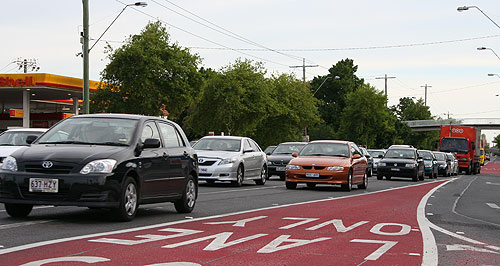Make / Model Search
News - General News - EmissionsAustralia set for tighter emissions capsEmissions: By July 1, 2018, all new light vehicles sold in Australia will have to meet Euro 6 standard, regardless of when they were launched. Motor industry welcomes phased Euro 5 emissions roll-out, despite misgivings13 Jun 2011 THE Australian motor industry has welcomed the phased introduction of Euro 5 light vehicle emissions standards from 2013, even though car companies still have misgivings that the more stringent controls will not only be inaffective unless Australia improves fuel quality but also make it harder to achieve CO2 emissions cuts. Federal transport minister Anthony Albanese announced the timetable for the new standards at the weekend after months of consultation with the local industry since the release last year of the government regulatory impact statement (RIS) on the adoption of the tighter exhaust emissions controls in line with Europe. The rollout of both Euro 5 and the even more stringent Euro 6 between November 2013 and mid-2018 reflects vehicle and engine development programs by the local car-makers Toyota, GM Holden and Ford. It also fits with export plans for Holden and Toyota, who regard Euro 5 as a default standard that needs to be achieved for many of the major export markets for both cars and engines. Originally, the government was proposing to introduce Euro 5 in 2012 and Euro 6 from 2016, but postponed both at the urging of the industry. Now, Euro 5 will be introduced in two stages, at least partly to give breathing space to manufacturers offering bio-fuel engines – such as Holden’s locally made, E85 ethanol-compatible SIDI V6 for the Commodore – to achieve cold-start emissions standards.  Left: Federal transport minister Anthony Albanese. Left: Federal transport minister Anthony Albanese.These engines will be exempted from a cold-start test (minus 7 degrees Celsius) on E85 under the first-stage “core Euro 5” standard, which is a watered-down version of the Euro 5 standards already in effect in Europe. This “core Euro 5” will be introduced on all new-model passenger cars, SUVs and light trucks launched from November 1, 2013. Vehicles launched before then will still be eligible for sale until the “full Euro 5” standard takes effect three years later, on November 1, 2016, when all vehicles will have to comply, regardless of when they were launched. However, whether that will apply in full to biofuels such as E85 is still up in the air, as a decision on the cold-start test requirements has been put on the back-burner until later this year. The more stringent Euro 6 standard rollout starts on July 1, 2017, when all new models introduced from that date need to comply. By July 1, 2018, all new light vehicles sold in Australia will have to meet Euro 6 standard, regardless of when they were launched. But again, some finetuning to the technical standards for Euro 6 still has to be done in negotiation with the motor industry as Europe is still to finalise its standards. According to the federal government, Euro 6 will cut exhaust emissions hydrocarbons by up to 50 per cent, oxides of nitrogen by up to 70 per cent and particulate matter – soot generated mainly by diesel engines – by 90 per cent over the current Euro 4 standard. Mr Albanese said the cut in vehicle pollution would reduce the public health bill by more than $1.5 billion over two decades. But motor industry insiders say the standards will not have the full positive effect unless Australia raises the quality of its petrol to levels comparable with Europe. They say that, to achieve the stated emissions standards under Euro 5 and 6, vehicle manufacturers have to run a test fuel from Europe. In its submission to the government on Euro 5 and 6 last year, the industry’s peak body, the Federal Chamber of Automotive Industries (FCAI), said the draft RIS failed to adequately address the disparity between fuel currently available in Australia and the fuel quality required for compliance with Euro 5/6. “Without fuel meeting the necessary fuel quality standards available in the market, the anticipated benefits from Euro 5/6 – that is, reduced vehicle emissions – will not be delivered,” the FCAI said in its submission. The Australian Institute of Petroleum (AIP) refuted those claims, arguing there were no implications for current fuel standards with the move to Euro 5/6 and that it did not support any further changes to the current Australian standards for petrol. In the end, the transport department decided that a sulphur standard of 150 parts per million in 91 RON petrol was not a barrier to the introduction of Euro 5-compliant vehicles, although it was not so sure about the long-term impact on emissions control devices such as catalysts. The department’s final RIS also quoted EC findings that Euro 5 would not increase CO2 emissions, although that is still disputed by some car-makers. Engineers say the bigger exhaust catalyst required to clean gases to Euro 5 standard increases back pressure, meaning the engine needs to work harder. In turn, this means the engine uses two to three per cent more fuel. A separate set of compulsory CO2 emissions standards are now under development in Canberra – rules that the industry believes might have greater financial impact on the industry and consumers than the Euro 5/6 pollution caps. The industry wanted the Euro 5/6 and CO2 regulations to be considered in parallel, arguing they were linked, but the government decided to treat them separately. In its official response to Saturday’s announcement by Mr Albanese, the FCAI said it endorsed the phased introduction of Euro 5 vehicle emission standards. FCAI chief executive Andrew McKellar described it as “a balanced and realistic outcome, ensuring that Australian vehicle emissions will be aligned with leading international standards”. “At the same time, the planned phase-in of these regulations recognises the practical impact on existing investments and the model development cycle,” he said. “The industry’s support for this initiative reflects its strong commitment to the advancement of vehicle emission standards and better environmental outcomes. “In practice, we are already seeing a growing number of Euro 5-certified vehicle models entering the Australian market.” Mr McKellar said he welcomed the government’s commitment to consult with industry on the technical requirements for Euro 6 before they were implemented.  Read more |
Click to shareGeneral News articlesResearch General News Motor industry news |












Facebook Twitter Instagram